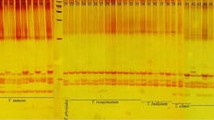Abstract
Microsatellite markers are a powerful tool for genetic studies, including germplasm conservation, cultivar identification, and integration of linkage maps. Several works have shown that primer pairs designed for one species can be used in related species to facilitate wider application because it reduces the costs for primer development. The objective of this study was to evaluate the transferability of microsatellite primers which was previously developed from the genomic library of Pêra sweet orange (Citrus sinensis L. Osbeck) and to determine the level of heterozygosity between citrus accessions and related genera. Twenty-four microsatellite loci were evaluated on 12 genotypes of Citrus, Poncirus, and an intergeneric hybrid. All analyzed markers were transferable across all genotypes. Seventeen loci were polymorphic, and the number of alleles per loci ranged from one to six. The lowest level of heterozygosity was observed for Poncirus trifoliata (L.) Raf. cultivars while the highest level was for Swingle citrumelo. In general, microsatellite markers showed wide genetic variation and demonstrated that they can be useful in citrus breeding programs.



Similar content being viewed by others
References
Barkley NA, Roose ML, Krueger RR, Federici CT (2006) Assessing genetic diversity and population structure in a citrus germplasm collection utilizing simple sequence repeat markers (SSRs). Theor Appl Genet 112:1519–1531
Barrett HC, Rhodes AM (1976) A numerical study of affinity relationships in cultivated citrus and its close relatives. Syst Botany 1:105–136
Bravo JP, Hoshino AA, Angelici CMLCD, Lopes CR, Gimenes MA (2006) Transferability and use of microsatellite markers for the genetic analysis of the germplasm of some Arachis section species of the genus Arachis. Genet Mol Biol 29(3):516–524
Brondani RPV, Brondani C, Tarchini R, Grattapaglia D (1998) Development, characterization and mapping of microsatellite markers in Eucalyptus grandis and E. urophylla. Theor Appl Genet 97:816–827
Cristofani M, Machado MA, Novelli VM, Souza AA, Targon MLPN (2000) Construction of linkage maps of Poncirus trifoliata and Citrus sunki based on microsatellite markers. In: Proc 9th International Society of Citriculture Congress, Orlando, USA, December, 2000, pp 175–178
Federici CT, Fang DQ, Scora RW, Roose ML (1998) Phylogenetic relationships within the genus Citrus (Rutaceae) and related genera as revealed by RFLP and RAPD analysis. Theor Appl Genet 96:812–822
Gupta PK, Varshney RK (2000) The development and use of microsatellite markers for genetic analysis and plant breeding with emphasis on bread wheat. Euphytica 113:163–185
Herrero R, Asíns MJ, Carbonell EA, Navarro L (1996) Genetic diversity in the orange subfamily Aurantioideae: I—intraspecies and intragenus genetic variability. Theor Appl Genet 92:599–609
Hodgson RW (1967) Horticultural varieties of citrus. In: Reuther W, Webber HJ, Batchelor LD (eds) The citrus industry. Berkeley, University of California, pp 431–589
Holton TA, Christopher JT, McClure L, Harker N, Henry RJ (2002) Identification and mapping of polymorphic SSRs markers from expressed gene sequences of barley and wheat. Mol Breeding 9:63–71
Ince AG, Karaca M, Onus AN (2010) Polymorphic microsatellite markers transferable across Capsicum species. Plant Mol Biol Rep 28:285–291. doi:10.1007/s11105-009-0151-y
Jiang D, Zhong GY, Hong QB (2006) Analysis of microsatellites in citrus unigenes. Acta Genet Sinica 33:345–353
Luro FL, Costantino G, Terol J, Argout X, Allario T, Wincker P, Talon M, Ollitrault P, Morillon R (2008) Transferability of the EST-SSRs developed on Nules clementine (Citrus clementina Hort ex Tan) to other Citrus species and their effectiveness for genetic mapping. BMC Genomics 9:287. doi:10.1186/1471-2164-9-287
Marshall TC, Slate J, Kruuk LEB, Pemberton JM (1998) Statistical confidence for likelihood-based paternity inference in natural populations. Mol Ecol 7:639–655
Moore GA (2001) Oranges and lemons: clues to the taxonomy of Citrus from molecular markers. Trends Genet 17(9):536–540
Murray MG, Thompson WF (1980) Rapid isolation of high molecular weight plant DNA. Nucl Acids Res 8:4321–4325
Novelli VM, Takita MA, Machado MA (2004) Identification and analysis of single nucleotide polymorphisms (SNPs) in citrus. Euphytica 138:227–237
Novelli VM, Cristofani M, Souza AA, Machado MA (2006) Development and characterization of polymorphic simple sequence repeats (SSRs) in sweet orange (Citrus sinensis L. Osbeck). Genet Mol Biol 29(1):90–96
Oliveira AC, Garcia A, Cristofani M, Machado MA (2002) Identification of citrus hybrids through the combination of a leaf apex morphology and SSR markers. Euphytica 128(3):397–403
Oliveira EJ, Pádua JG, Zucchi MI, Vencovsky R, Vieira MLC (2006) Origin, evolution and genome distribution of microsatellites. Genet Mol Biol 29(2):294–307
Rafalski JA, Vogel JM, Morgante M, Powell W, Andre C, Tingey SV (1996) Generating and using DNA markers in plants. In: Birren B, Lai E (eds) Analysis of non-mammalian genomes—a practical guide. Academic, New York, pp 75–134
Rohlf FJ (1993) NTSYS-pc, numerical taxonomy and multivariate analysis system, version 2.02g. Exeter Software, Setauket
Ruiz C, Asins MJ (2003) Comparison between Poncirus and Citrus genetic linkage maps. Theor Appl Genet 106:826–836
Swingle WT, Reece PC (1967) The botany of Citrus and its wild relatives. In: Reuther W, Webber HJ, Batchelor LD (eds) The citrus industry. Berkeley, University of California, pp 190–422
Zane L, Bargelloni L, Patarnello T (2002) Strategies for microsatellite isolation: a review. Mol Ecol 11:1–16
Zucchi MI, Brondani RV, Pinheiro JB, Brondani C, Vencovsky R (2002) Transferability of microsatellite markers from Eucalyptus spp. to Eugenia dysenterica (Myrtaceae family). Mol Ecol Notes 2:512–514
Acknowledgments
This work was supported by the Conselho Nacional de Desenvolvimento Científico e Tecnológico (CNPq) and Fundação de Amparo à Pesquisa do Estado de São Paulo. MCY, VMN, and MAM are recipients of research fellowships from CNPq.
Author information
Authors and Affiliations
Corresponding author
Rights and permissions
About this article
Cite this article
Cristofani-Yaly, M., Novelli, V.M., Bastianel, M. et al. Transferability and Level of Heterozygosity of Microsatellite Markers in Citrus Species. Plant Mol Biol Rep 29, 418–423 (2011). https://doi.org/10.1007/s11105-010-0241-x
Published:
Issue Date:
DOI: https://doi.org/10.1007/s11105-010-0241-x




